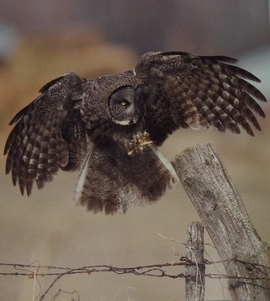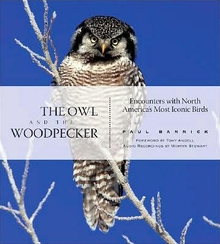Reviewed by Grant McCreary on October 31st, 2008.
When reading The Owl and the Woodpecker, one quickly becomes aware that it is unlike most books dedicated to specific families of birds. Although filled with fabulous pictures, it is not a traditional coffee table book. While presenting information about the birds’ lives, it is not a collection of life histories. The author utilizes both of these aspects not only to present these birds, but also their habitat, and especially how they all relate together.
This book covers all of the regularly occurring owls and woodpeckers in North America, north of Mexico. Upon first seeing this book’s title and description, it seemed weird that a single book would attempt to cover both groups of birds. However, the author makes it clear that these birds are very closely associated ecologically. To understand the relationship, two key terms need to be defined:
Indicator species
– A species whose presence, absence, or relative well-being in a given environment is indicative of the health of its ecosystem as a whole.
Keystone species
– A species whose presence and role within an ecosystem has a disproportionate effect on other organisms within the system.
 Most owls, as predators at the top of the food chain, are considered indicator species for their environments. Problems tend to manifest themselves first in these apex species. A few woodpeckers are also good indicator species due to their specific habitat requirements. A keystone species is one that serves a crucial role in the ecosystem, and essentially holds the entire thing together. Most woodpeckers are keystone species due to one thing – cavities. The nesting cavities that they create are in turn used by many other species, including owls. More than half of the North American owls rely at least somewhat on woodpecker cavities for nesting.
Most owls, as predators at the top of the food chain, are considered indicator species for their environments. Problems tend to manifest themselves first in these apex species. A few woodpeckers are also good indicator species due to their specific habitat requirements. A keystone species is one that serves a crucial role in the ecosystem, and essentially holds the entire thing together. Most woodpeckers are keystone species due to one thing – cavities. The nesting cavities that they create are in turn used by many other species, including owls. More than half of the North American owls rely at least somewhat on woodpecker cavities for nesting.
The book is divided into eleven chapters based on habitat. Each chapter focuses on the characteristic owls and woodpeckers of that habitat, one after the other. When field guides try to organize species in this manner, the results are usually dreadful. But it works here, as it emphasizes the interconnectedness of these birds.
Habitat requirements, feeding, breeding, and other basic information is given for each of these 41 birds, along with some of the author’s own personal experiences sprinkled in. The large number of species and copious photographs results in a relatively small amount of space dedicated to each bird. Thus, these are not comprehensive species accounts. However, Bannick does a good job getting the important concepts across, and even includes some cool facts. Here are just a few that I had not known and found interesting:
- The Northern Flicker has the longest tongue of any woodpecker, 1.6 inches beyond bill tip (not clear if that is just for North America, or the entire world)
- It has been theorized that since the White-headed Woodpecker is a visual hunter, the white head is an adaptation to reflect light into dark crevices
- The Red-cockaded Woodpecker scales pine bark, which causes the trees to turn reddish (this might be a good sign for birders seeking this species, in addition to the white sap stain around nesting cavities)
Fittingly, the chapters conclude with notes on conservation, including risks to the habitat and birds, and what can be done to help protect them.
The photography, also provided by Bannick, is fantastic. Anywhere from one to ten photos of each species are included, along with some of habitats and other species impacted by the titular groups, such as Brown-headed Nuthatch and American Kestrel.
The best thing about these pictures is that they convey a sense of intimacy. For the most part, these birds are going about their normal routines as if the photographer was not present. You see owls bringing back prey for their nestlings, woodpeckers removing fecal sacs from their nest holes (and one sapsucker removing an infertile egg!), and nestlings fledging. The viewer is left with the impression that the photographer has spent long hours with his subjects, and has attained an uncommonly high level of familiarity with them.
 A few photographs really stand out. On one page, the author describes how Yellow-bellied Sapsuckers will catch wasps coming to feed at the bird’s sap wells. The sapsucker tilts its head back and follows the wasp in until it is close enough to nab. Two pages later, there was the sapsucker, its head turned back just as I had imagined, staring at a wasp forever frozen in time mere inches away from its demise. Another superb image captures a Great Gray Owl coming in to land on a fence posts. The action is relatively tame compared to many in-flight shots of these majestic owls that I’ve seen. However, the owl’s head and outstretched talons are in sharp focus, while the rest of the bird seems soft, giving it an incredible ethereal quality. I don’t know if the effect was due to the conditions and bird itself, or if the camera introduced it (and if so, if it was intentional). Regardless, the result is stunning.
A few photographs really stand out. On one page, the author describes how Yellow-bellied Sapsuckers will catch wasps coming to feed at the bird’s sap wells. The sapsucker tilts its head back and follows the wasp in until it is close enough to nab. Two pages later, there was the sapsucker, its head turned back just as I had imagined, staring at a wasp forever frozen in time mere inches away from its demise. Another superb image captures a Great Gray Owl coming in to land on a fence posts. The action is relatively tame compared to many in-flight shots of these majestic owls that I’ve seen. However, the owl’s head and outstretched talons are in sharp focus, while the rest of the bird seems soft, giving it an incredible ethereal quality. I don’t know if the effect was due to the conditions and bird itself, or if the camera introduced it (and if so, if it was intentional). Regardless, the result is stunning.
The only problem with the photos is that they are not labeled with the date and location. Every book such as this should include this information.
An appendix contains a “Field Guide” to the owls and woodpeckers covered in this book. This is a misnomer, as it is really a species account summary for each bird. Each account contains:
- Photo – a very small thumbnail of a photo from the book
- Description – basic characteristics, including the length and wingspan in inches
- Similar Species
- Interesting Fact – mostly gleaned from the main text
- North American Distribution and Habitat
- Nesting – when, where, and brood size
- Vocalization
Each section is very terse, containing a few sentences at most. Range maps would have been nice, and the page number of the species account in the main text definitely should have been included. Honestly, I can’t see this section getting much use.
As an unexpected bonus, an audio CD is also included with the book. It contains one track for each owl and woodpecker. The tracks open with a narrator speaking the species name, followed by the songs and calls (and for most woodpeckers, drumming). Overall, I found them to be slightly inferior to the Stokes CD sets, both in terms of audio quality and number of vocalizations included. It is still a welcome inclusion, especially for those without other collections of bird sounds.
Recommendation
Before reading The Owl and the Woodpecker, I was aware that many owls nested in woodpecker-produced cavities. But when I first saw this book’s title, I still thought it was an odd pairing. Their association just didn’t click with me. But now, this book has given me a much better understanding of not only the relationship between these fascinating birds, but also the wider roles that they play in their environment. One of the author’s stated purposes in producing this work was to give readers a greater appreciation of these birds and their habitat. That is a worthy goal, and one that has been achieved.
Disclosure: I get a small commission for purchases made through links in this post.
Disclosure: The item reviewed here was a complementary review copy provided by the publisher. But the opinion expressed here is my own, it has not been influenced in any way.





 (3 votes, average: 4.67 out of 5)
(3 votes, average: 4.67 out of 5)
Thanks for the review. I ordered the book from amazon.de and can’t wait to read it. A similar book is missing for European Owls and Woodpeckers.
By the way: I am currently reading “Consider the birds” by Colin Tudge. You might be interested in that as well. So far I’ve read about 120 pages and I think it’s wonderful and the writing is awesome.
See here for more for a review by Stephen Moss:
http://www.guardian.co.uk/books/2008/nov/22/consider-the-birds-colin-tudge